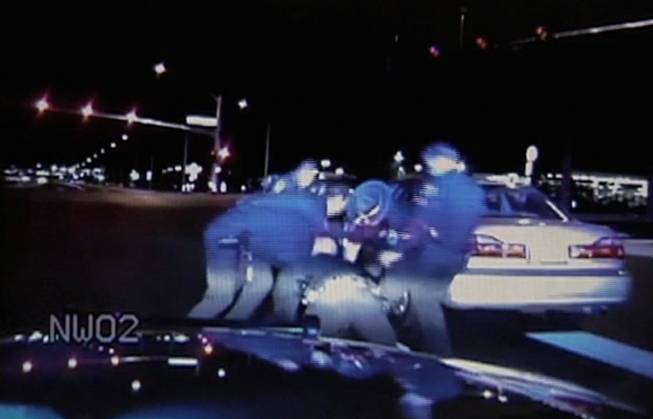
Nevada Highway Patrol
A screen grab from the video of an incident with Henderson Police.
Wednesday, Feb. 15, 2012 | 2 a.m.
Man kicked in the head by Henderson Police officer
Video footage from a Nevada Highway Patrol dashboard camera of a Henderson Police officer kicking a man in the head during a traffic stop, Feb. 7, 2012. Warning: The footage contains material that may be offensive.
Man kicked during traffic stop speaks out
KSNV coverage of a man speaking out after being kicked by a Henderson Police officer while he was having a medical episode, Feb. 8, 2012.
Related stories
Related document
It was only because a Highway Patrol cruiser was equipped with a camera that the public learned a Henderson motorist in the throes of a diabetic episode had been held down and kicked by police officers.
Outrage over the incident has included calls for all police vehicles to be equipped with cameras, but there is disagreement over how quickly it could happen.
The head of the union representing Las Vegas Police said installation of dashboard cameras would have to be negotiated under future contracts. But a member of the committee of elected officials who oversee Metro’s finances said that isn’t the case.
The Sun reported last week on the Nevada Highway Patrol video showing a Henderson police officer kicking driver Adam Greene, who was restrained on the ground. The city has settled with Greene and his wife for about $250,000.
At the time of the October 2010 incident, Henderson police did not have dashboard cameras in their vehicles, but the Highway Patrol did.
Last year, Henderson used a $1.2 million federal grant to install them in 150 vehicles.
Chris Collins, executive director of the Las Vegas Police Protective Association union, said that for Southern Nevada’s largest force, Metro Police, to have its vehicles equipped with video cameras it would be “a piece of safety equipment they would have to negotiate with us.”
But Clark County Commissioner Steve Sisolak, a member of the Fiscal Affairs Committee that oversees Metro’s spending, said if money is available, either through grants or surplus funds Metro carries from year to year, he would support immediate installation of dashboard cameras.
“I don’t understand how equipment would be a negotiated item any more than the type of vehicles or uniforms,” Sisolak said, adding that most police departments already use dashboard cameras.
Indeed, hundreds of police departments nationwide are now testing cameras that officers wear on their clothing that record interactions between the officer and the public.
But if Metro, whose sheriff often pledges to run a transparent department, is considering dashboard cameras, no one has told the police union.
The sheriff could not be immediately reached for comment.
Sisolak said video of police stops would protect officers against false accusations.
“It provides another level of transparency and gives the public another level of comfort with our police force,” he said.
Police videos around the country are cited in legal battles, weeding out false accusations of police brutality or misconduct.
In November, Midland, Texas, police officers were found justified in a fatal shooting, in part because of dashboard video. Video cleared Monona, Wis., officers in a questioned shooting of a kidnapper in December 2010. Officers were also cleared of wrongdoing in Sioux City, Iowa, when video disproved a woman’s allegations that she was mistreated by police during an arrest in January.
After the Henderson incident, Nevada Highway Patrol Major Kevin Tice said he believed every police vehicle in the country would have dashboard cameras.
“They’ve been a real nice tool” for accountability, he said. “We defend ourselves, and the way we do that is to hold our people accountable.”
But some police departments and cities remain wary of video. The city of Seattle and its police department, facing accusations of excessive force, have been sued seeking release of video footage. The department has lost tens of thousands of videos, the station, KOMO-TV, reported.
On Monday, the station showed police video of a Seattle officer telling a suspect — who was never charged — that he would “make stuff up” to uphold a robbery charge.
Attorney James Egan, who is seeking 36 videos from the Seattle Police Department, has been sued by the city, which wants the courts to decide if he is entitled to them. Seattle maintains it has the right to keep videos from the public for three years, its interpretation of the Privacy Act.
“It’s very self-serving,” Egan said, adding that suspicions are heightened by the fact that “three years after an incident is when the videos are slated for deletion.”
Egan said that in 2005, a Microsoft executive suffering a diabetic reaction was hit with a Taser by a Redmond police officer because she refused to open her door. The executive received a $150,000 settlement.
Egan said if Metro Police install dash cams, they “should show their hand by putting videos online within two days to a week of an encounter.” That would avoid some of the problems Seattle has had, he said.
Sisolak said he’s going to ask the police department to find money to install cameras in squad cars.
“I want to see how this might be paid for,” he said. “I think it’s something we should definitely look at.”

Join the Discussion:
Check this out for a full explanation of our conversion to the LiveFyre commenting system and instructions on how to sign up for an account.
Full comments policy